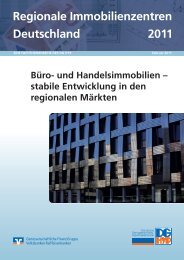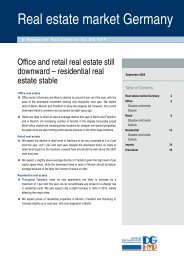ANNUAL REPORT 2006 - DG Hyp
ANNUAL REPORT 2006 - DG Hyp
ANNUAL REPORT 2006 - DG Hyp
You also want an ePaper? Increase the reach of your titles
YUMPU automatically turns print PDFs into web optimized ePapers that Google loves.
d) Management of problem loans<br />
<strong>DG</strong> HYP has developed an early warning system for its<br />
investors. This uses a variety of indicators to highlight the<br />
necessity for more intensive handling of the loan account.<br />
A differentiation is made between compulsory and optional<br />
requirements, as a result of the parameter weighting.<br />
The effectiveness of the indicators is reviewed on a quarterly<br />
basis. All cases of intensified handling are reported on<br />
a quarterly basis. In addition, all borrowers under intensive<br />
handling with a volume of more than € 10 million are<br />
reported once per month. Within the scope of monitoring,<br />
as a rule, a checklist is maintained for all such exposures<br />
subject to intensive handling, which provides information<br />
on the renewed review of collateral, the property and rating<br />
assessment, as well as measures that have already been<br />
initiated. At the same time, the outcome of this intensive<br />
review forms the basis for the decision on further support<br />
measures (normal or intensified handling, or restructuring).<br />
The intensive handling phase is generally limited to<br />
twelve months. This is followed by a review as to whether<br />
a return to normal coverage is possible, or if a handover to<br />
the restructuring/workout division is required.<br />
Those problem credit exposures whose economic perspective<br />
can be assessed as positive are processed in the<br />
restructuring department, which forms part of the backoffice.<br />
Submitting a concept that must comprise a differentiated<br />
analysis and assessment of the overall situation of<br />
the exposure and a cost-benefit analysis, as well as a comprehensive<br />
restructuring plan, forms the basis for a restructuring<br />
decision. Loan exposures are transferred to workout<br />
if restructuring has failed or if this is deemed to be fruitless<br />
from the outset.<br />
Non-performing retail loan exposure is included in an<br />
integrated reminder and restructuring process within<br />
<strong>DG</strong> HYP at an early stage. Initial telephone contact with the<br />
borrower is made two to four weeks after the first<br />
reminder. If standardised activities (e. g. short-term postponement<br />
of the outstanding instalment) are unsuccessful,<br />
the non-performing loan exposures are transferred to the<br />
restructuring department. The probability of successful<br />
38 Deutsche Genossenschafts-<strong>Hyp</strong>othekenbank AG | Annual Report <strong>2006</strong><br />
Management Report<br />
restructuring is then assessed in detail, and further action<br />
implemented based on the results. The focus is on stabilising<br />
the customer and recovering the outstanding amounts.<br />
If it is not possible to restructure the exposure, the loan<br />
exposures are transferred to workout for rapid liquidation<br />
of the collateral.<br />
e) Portfolio management<br />
Besides the management of individual credit risks,<br />
active portfolio management is central to <strong>DG</strong> HYP’s risk<br />
management process. This comprises both the assessment<br />
of individual exposures from a portfolio perspective and<br />
the risk/return-oriented management of the overall portfolio<br />
through securitisations, MBS purchases, and the<br />
acquisition and disposal of loan portfolios. Risk Management<br />
and Credit Treasury are jointly responsible for portfolio<br />
management, while Credit Treasury alone is charged<br />
with implementing the approved strategy.<br />
Credit Risk Controlling uses a credit risk model (based<br />
on CreditRisk+TM) to measure the counterparty risks on the<br />
basis of a portfolio analysis involving all asset classes.<br />
A Credit Value at Risk (CVaR), calculated with a confidence<br />
interval of 99.9 per cent and a one-year holding period,<br />
serves as the basis for limiting counterparty risk across the<br />
entire bank as well as for portfolio management in Credit<br />
Treasury. This process allows the bank (amongst other<br />
things) to calculate the risk contribution of individual exposures<br />
in terms of diversification within the overall portfolio,<br />
and the ensuing utilisation of economic capital. The results<br />
of credit risk modelling are used particularly efficiently, as<br />
part of the so-called CVaR analysis. In this analysis, which<br />
is conducted monthly, the impact of current transactions –<br />
for example placements or portfolio purchases – are ascertained<br />
and reported as part of the overall risk report, as are<br />
all material changes to the risk structure at an individual<br />
customer level and division level, as well as changes to the<br />
ten largest risk drivers. The results of this regular analysis<br />
are continuously integrated in the credit risk strategy, and<br />
are taken into consideration as an additional parameter in<br />
the process of granting large-volume loans (upwards of<br />
€ 25 million).














